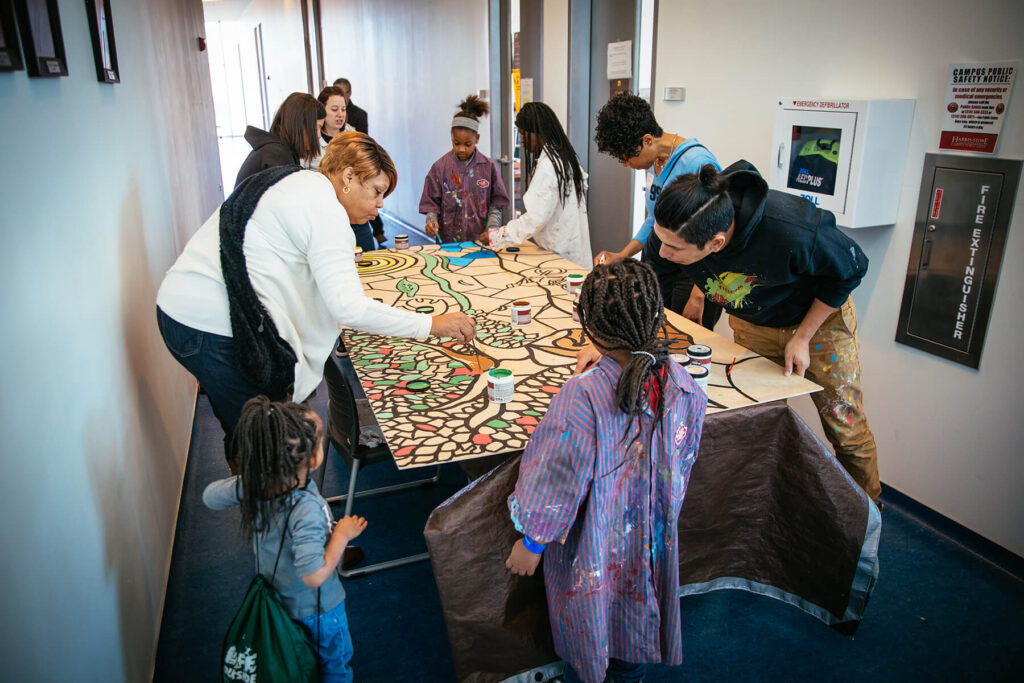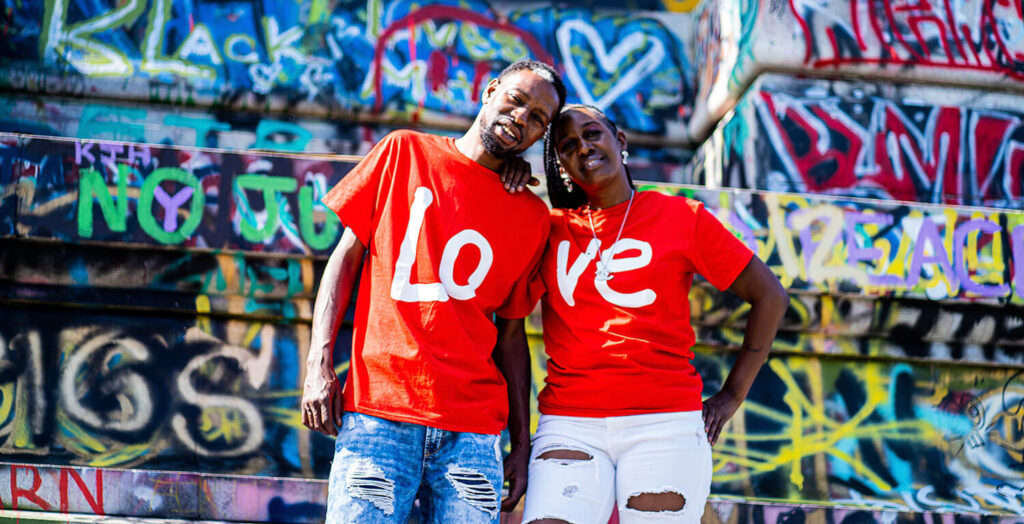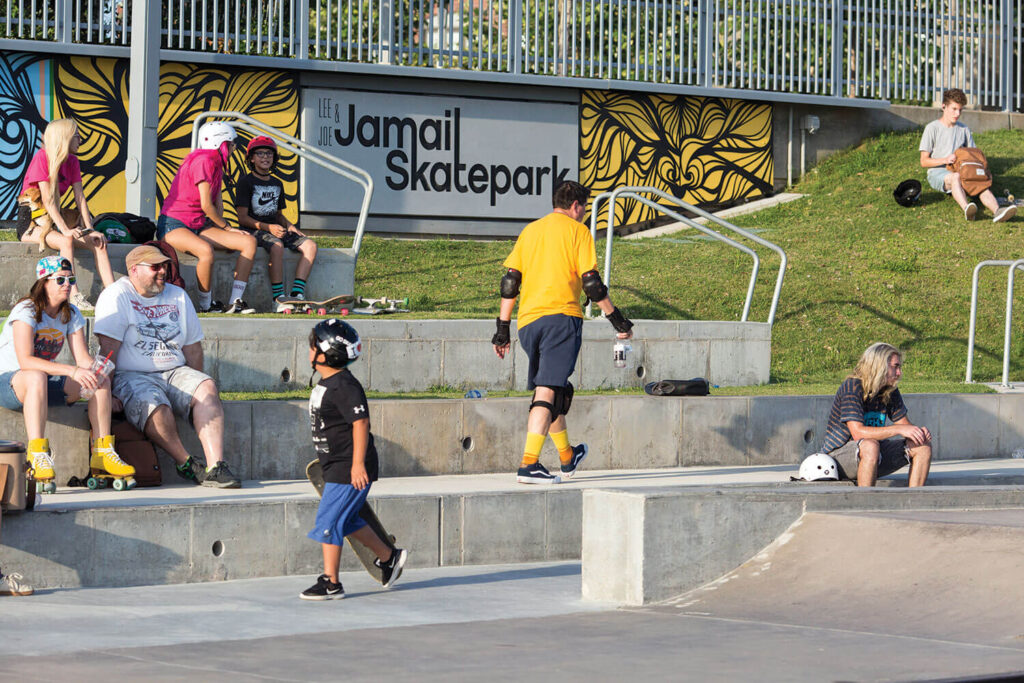Would you like to showcase your own work to embed equity in your infrastructure reuse project?
Equity-Based Priorities for NYC’s New Parks and Public Spaces

Aerial view of the High Line’s reuse process from elevated railway to park. Credit: Timothy Schenck, The High Line
From Long Island City to Staten Island and from the Bronx River to Gowanus Canal, New York City is a hotspot for innovation in the public realm. But existing and emerging public parks alike face similar challenges, putting increased pressure on the city to optimize support and services for much needed community spaces. Considering citywide issues, including neighborhood affordability, what can the next generation of public parks––specifically infrastructure reuse projects––tell us about the needs of New York City parks?
New York City carries the burden of environmental impacts. Its economic footprint and transportation infrastructure has determined the location of factories, industries, and highways along its waterways, scarring and splitting neighborhoods apart. To this day, these two factors continue impacting the health and environmental determinants of residents, creating a charged legacy for public space advocates. To make matters worse, inherent challenges in operating, activating, and funding public space are present in traditional parks and new park organizations alike, regardless of their missions, budgets or staff capacity.
What can we learn from new infrastructure reuse projects? Parks or public space organizations can assess their work using the Review Your Initiatives tool. This tool uses a method called Park-In, Park Out. Park-In refers to internal work, such as staffing practices. Park-Out refers to efforts beyond the immediate geographic impact and direct activities, including programs or partnerships with community partners. The High Line Network led a workshop with seven members of the High Line’s Public Space Alliance (PSA) to assess the current impact of infrastructure reuse park projects in New York City. The goal: create a snapshot of what infrastructure reuse projects in New York City are currently doing––or should be––to embed equity through their work.
The High Line Network began by asking workshop participants to define equity. Common responses referenced ensuring fair treatment; prioritizing access to public space for students, workers, residents, and general visitors; overcoming transportation barriers; and building awareness of park programs and services within priority populations. This last point is critical, as it determines how parks can embed equity, and for whom their programs should be designed. Not only does this indicate a need for targeted outreach. It becomes a guiding star to create activities, events, and programs.
Assessing initiatives showed that many New York infrastructure reuse projects are evolving, with several transitioning from volunteer-led groups to nonprofit organizations with legal status. This presents a pivotal moment for public and private investors to support the capacity-building of nonprofit park organizations, especially those involved in infrastructure reuse.
Participants also experiment with collective decision-making structures. Whether through community committees or equity coalitions, advocacy shapes how these organizations are creating their own accountability systems, despite the difficulties early-phase infrastructure reuse projects face to maintain them. The sustainability of these efforts, guaranteed through additional and more specific funding, would foster a more equitable decision-making process and promote collective power sharing.
The participants’ assessment of community-facing work showed investment in public space activation activities such as art, music, dance, and movie nights, with options available for all demographics. This indicates their primary focus is to promote a thriving civic life, with increased general community use of public space as the priority equitable outcome, thus accelerating these sites as hubs for community use.
Secondary areas of interest are health, wellness, and resilience. Programming includes curated nature walks or historic landmark tours, typically led by community-based or volunteer groups. Local partnerships with education institutions are another opportunity these projects are taking to co-develop environment-focused curricula for a range of ages. These ongoing initiatives, organized around areas of interest through strategic partners, have the potential to increase overall reach and impact of their community engagement.
Park organizations around New York City continue to gain traction and support through site activations, partnerships, and outreach, yet still struggle to scale operations and fully activate their spaces. Capital funding and guaranteed public support are two key resources these projects need to thrive. Immediate challenges include improving neighborhood accessibility and connectivity, while expanding local partnerships, and prioritizing organizational capacity and growth. To further equitable development goals, these organizations must continue to advocate for increased funding and political support, while expanding relationships and trust with community constituents, public agencies, and philanthropic entities. Although these challenges are not small, they are achievable. New York City infrastructure reuse projects have the potential to become fully operational community hubs, setting a new precedent—and the standard—for equity-driven public space initiatives.
Project Org
The High LineRelated Toolkit Section
Center EquityRelated Tool
REVIEW YOUR INITIATIVESFrom Long Island City to Staten Island and from the Bronx River to Gowanus Canal, New York City is a hotspot for innovation in the public realm. But existing and emerging public parks alike face similar challenges, putting increased pressure on the city to optimize support and services for much needed community spaces. Considering citywide issues, including neighborhood affordability, what can the next generation of public parks––specifically infrastructure reuse projects––tell us about the needs of New York City parks?
New York City carries the burden of environmental impacts. Its economic footprint and transportation infrastructure has determined the location of factories, industries, and highways along its waterways, scarring and splitting neighborhoods apart. To this day, these two factors continue impacting the health and environmental determinants of residents, creating a charged legacy for public space advocates. To make matters worse, inherent challenges in operating, activating, and funding public space are present in traditional parks and new park organizations alike, regardless of their missions, budgets or staff capacity.
What can we learn from new infrastructure reuse projects? Parks or public space organizations can assess their work using the Review Your Initiatives tool. This tool uses a method called Park-In, Park Out. Park-In refers to internal work, such as staffing practices. Park-Out refers to efforts beyond the immediate geographic impact and direct activities, including programs or partnerships with community partners. The High Line Network led a workshop with seven members of the High Line’s Public Space Alliance (PSA) to assess the current impact of infrastructure reuse park projects in New York City. The goal: create a snapshot of what infrastructure reuse projects in New York City are currently doing––or should be––to embed equity through their work.
The High Line Network began by asking workshop participants to define equity. Common responses referenced ensuring fair treatment; prioritizing access to public space for students, workers, residents, and general visitors; overcoming transportation barriers; and building awareness of park programs and services within priority populations. This last point is critical, as it determines how parks can embed equity, and for whom their programs should be designed. Not only does this indicate a need for targeted outreach. It becomes a guiding star to create activities, events, and programs.
Assessing initiatives showed that many New York infrastructure reuse projects are evolving, with several transitioning from volunteer-led groups to nonprofit organizations with legal status. This presents a pivotal moment for public and private investors to support the capacity-building of nonprofit park organizations, especially those involved in infrastructure reuse.
Participants also experiment with collective decision-making structures. Whether through community committees or equity coalitions, advocacy shapes how these organizations are creating their own accountability systems, despite the difficulties early-phase infrastructure reuse projects face to maintain them. The sustainability of these efforts, guaranteed through additional and more specific funding, would foster a more equitable decision-making process and promote collective power sharing.
The participants’ assessment of community-facing work showed investment in public space activation activities such as art, music, dance, and movie nights, with options available for all demographics. This indicates their primary focus is to promote a thriving civic life, with increased general community use of public space as the priority equitable outcome, thus accelerating these sites as hubs for community use.
Secondary areas of interest are health, wellness, and resilience. Programming includes curated nature walks or historic landmark tours, typically led by community-based or volunteer groups. Local partnerships with education institutions are another opportunity these projects are taking to co-develop environment-focused curricula for a range of ages. These ongoing initiatives, organized around areas of interest through strategic partners, have the potential to increase overall reach and impact of their community engagement.
Park organizations around New York City continue to gain traction and support through site activations, partnerships, and outreach, yet still struggle to scale operations and fully activate their spaces. Capital funding and guaranteed public support are two key resources these projects need to thrive. Immediate challenges include improving neighborhood accessibility and connectivity, while expanding local partnerships, and prioritizing organizational capacity and growth. To further equitable development goals, these organizations must continue to advocate for increased funding and political support, while expanding relationships and trust with community constituents, public agencies, and philanthropic entities. Although these challenges are not small, they are achievable. New York City infrastructure reuse projects have the potential to become fully operational community hubs, setting a new precedent—and the standard—for equity-driven public space initiatives.
Share this Case Study


